North Karnataka Trip - III
Gol Gumbaz
We got up at 6AM on Sunday, and after taking bath, had a good breakfast from Kamat hotel again. At 8:30, we started towards Gol Gumbaz. We reached there within ten minutes, and a new tourist guide came towards us and introduced himself. He seemed to be very talkative, and very emotional about the monuments at Bijapur.
Gol Gumbaz is the tomb of Mohammed Adil Shah, who ruled Bijapur during the seventeenth century. It is 51 meters tall, and the central dome has a diameter of 37 meters, making it the second largest dome in world (the first one is the dome of St Peter's Basilica at Rome). Gol Gumbaz was constructed without using metal, and the massive dome is supported only by the walls of the tomb building. There is a mosque to the left of Gumbaz (our guide told that there would be one near any Muslim tomb), and an ancient building in front of Gumbaz has been converted to a museum by the archeology department.
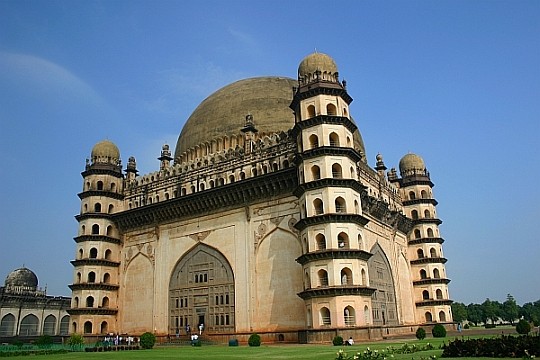
Gol Gumbaz
Our guide gave us some background regarding the Gumbaz and the Adil Shahi dynasty. It seems several buildings in the city were destroyed by Aurangazeb when he invaded Bijapur, but the tombs and mosques were spared. Just like other Muslim tombs, the real grave is below ground level, and a symbolic tombstone is kept in the tomb building exactly above the real grave.
When we entered the tomb, what attracted me first were the echoes of human voices, which made it look as if it was a haunted building. The dome is constructed in such a way that any feeble voice would be echoed twenty one times in the tomb building. Our guide demonstrated this by shouting loudly and asking us to count the echoes, but I lost count after ten as the fading echoes got lost in the more stronger ones of the voices of other people who also wanted to experiment and verify the count. It seems, in an utmost quite atmosphere, even the voice of a pin-drop would be echoed and could be heard everywhere inside the tomb building.
There are four turrets at four corners of the Gumbaz, and we could climb up to the terrace of the building through the stairs inside a turret. This is a very difficult climb, as the stairs are steep and narrow. From the sixth floor of the turret, we could come out to the terrace of the tomb building. We could get a beautiful view of Bijapur town from there, and the remains of 10-kilometer long fort surrounding the town can also be seen. At one side, there is an opening in the dome, and through that we entered inside the "whispering gallery" of the tomb.
To demonstrate the specialty of acoustical system in the dome, our guide asked us to stand at one place in the gallery, and then he walked to a diametrically opposite point (It is 37 meters away from us). He whispered few words from there, and the voice reached us through echoes, and we could hear it as if through a telephone! Then we were given fifteen minutes to spent there and experiment the "wireless system" ourselves; Achchan wanted to try this out, and he walked to a diametrically opposite point and then talked something to us. However, we couldn’t hear anything as almost everybody were performing the "whisper test", and we could hear nothing but a crowd of echoes.
We climbed down through another turret, and spent few minutes in the lawn in front of the Gumbaz, taking photographs. Then, we went back to the bus. The next destination was the Jama Masjid.
Jama Masjid
The Jama Masjid was built during the sixteenth century by the Bijapur rulers, and it was later enhanced by Aurangazeb. It seems this is the largest mosque in South India. Our guide had shifted to Kannada by then, and I couldn’t understand much of what he spoke.
We spent just ten minutes at the Masjid, and then went to Ibrahim Rauza.
Ibrahim Rauza
Ibrahim Rauza was constructed by Ibrahim Adil Shah, the sixth Sultan of the Adil Shahi dynasty, as a mausoleum for his queen, Taj Sultana. But the king died before the queen, and he was buried there, hence the building was called Ibrahim Rauza. When Aurangazeb came to Deccan, he used Ibrahim Rauza as his residence. Unlike other tomb buildings, at Ibrahim Rauza, the tomb building, accompanying mosque and the front entrance are in nearly equal sizes and they all stand together to make a beautiful view. A vast lawn in front of the tomb enclosure adds more color to it.
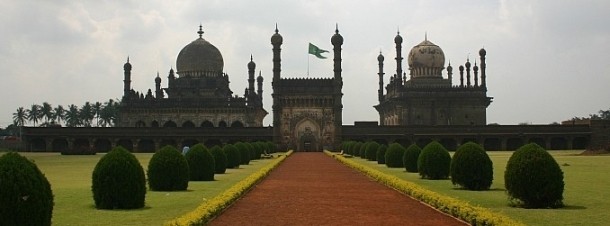
Ibrahim Rauza
Our guide was very enthusiastic to give us few details regarding Ibrahim Rauza. He asked us to look at the tomb enclosure from three angles, by covering some parts of the view using our hands and fingers - From one place, the tomb building looks like Taj Mahal. The mosque, when looked alone, looks like Bibi Ka Maqbara, the tomb of Aurangazeb's queen at Aurangabad. The entrance of the tomb enclosure looks like the Char Minar building at Hyderabad. The guide also pointed us towards some architectural differences between the Mughal buildings and the Adil Shahi buildings: The Mughal buildings have semi-spherical domes whereas the domes in Bijapur buildings cover more of the sphere. The minars in Mughal buildings are circular, with diameter decreasing with height. However, the minars of Bijapur have octagonal minars that have a constant area of cross section.
Inside the sepulcher, there are tombstones of Ibrahim Adil Shah, his mother, queen and children. It seems this beautiful building was mostly in the ruins when the British discovered it during the eighteenth century, after which they renovated it. We could see concrete works and iron rings installed near the tomb building, as a means of protection for the old building. The doors of the tomb building are made of teak wood and metal, and they have some interesting carvings on it. Our guide demonstrated that the door still remains completely functional, by closing the door and showing that it closes so perfectly, without leaving any gap anywhere.
Malik-e-Maidan
From Ibrahim Rauza, we went to a part of the fort where a huge metal gun, weighing 55 tons, is kept. This huge cannon is made of bell metal, and it is 4.45 meters long. When touched, the gun would look cool even under the roasting sun.
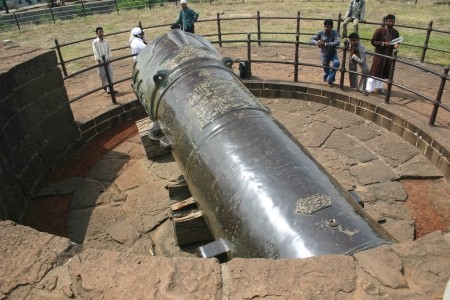
Malik-e-Maidan, the famous canon of Bijapur.
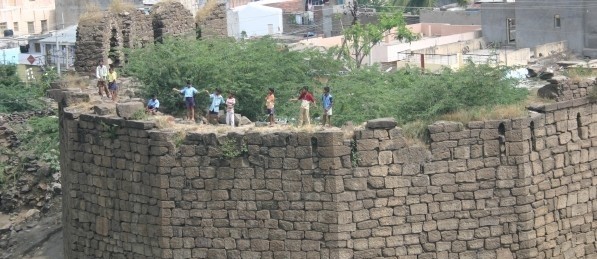
Children playing on top of the ruined fort at Bijapur, near Malik-e-Maidan.
We were given only ten minutes at Malik-e-Maidan, and then we were asked to hurry up. There are several more monuments at in the town, but we didn’t stop at any of them. At none junction in the road, the guide pointed us towards one direction, where the ruins of an old building were seen. These are the remains of Barah Kaman, the unfinished tomb of Ali Shah. It was planned as a huge building with twelve (hence, Barah) arches. This ambitious project, if completed, would have become the eighth wonder in the world, in the opinion of our guide.
Soon, it was time to leave Bijapur, and our guide got down from the bus after a pretty long departing speech. It was around 12, and our next destination was Kudala Samgama, on the way to Hospet.
Kudala Samgama
We reached Kudala Samgama at 2. We first went to Kamat Upachar hotel there for lunch.
After lunch, we went to the Samgameshwara temple. This was the place where saint Basaveshwara sat and meditated during the 12th century, and it was also the place where the saint attained Samadhi. Behind the temple, the rivers Krishna and Ghataprabha merge together, and a vast expanse of water could be seen. Some of our co-passengers went for boating, but we chose to spend some time in the temple compound itself. At one place, there is a cylindrical concrete building that has a Shivalinga installed at the basement, which is below the water level. This is supposed to be the place where the saint Basaveshwara attained Samadhi. We sat near the temple for some time as it was very cool there. Drops of water come out through a small opening in the basement of the temple, which people were drinking as the sacred theertha.
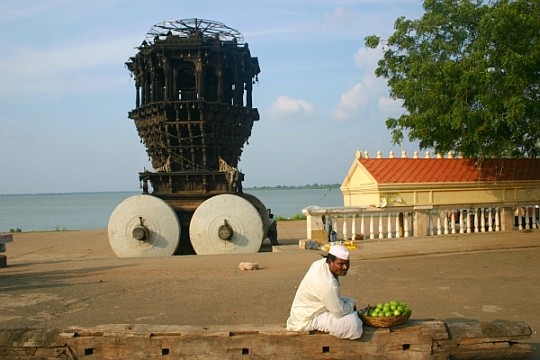
A fruit seller in front of the temple chariot, at Kudala Samgama.
At 4, we were back to the bus, and our tour coordinator asked us to have some food from Kamat hotel itself, as there would be no decent hotel on the way till Hospet. We bought some bajjis packed, and had some tea from Kamat. Near the hotel, we could see the metal roofs of a huge building - It looked very much out of place in the nearby village surroundings. I had seen it during lunch time itself, and I was thinking that it would be the Samgameshwara temple. However, I couldn’t figure out what it was.
Sunflower fields under the evening sky made a beautiful sight on our return trip. We reached Hospet at around 8PM. Our bus stopped in front of a pathetic restaurant. I ate a dosa from there, and at 9:30, we started our journey back to Bangalore. We were traveling through the horrible Bangalore - Hospet road again, and at many a place we were thrown up from our seats when the bus passed through some gutter. At 5AM on Monday, we reached Bangalore.
We got up at 6AM on Sunday, and after taking bath, had a good breakfast from Kamat hotel again. At 8:30, we started towards Gol Gumbaz. We reached there within ten minutes, and a new tourist guide came towards us and introduced himself. He seemed to be very talkative, and very emotional about the monuments at Bijapur.
Gol Gumbaz is the tomb of Mohammed Adil Shah, who ruled Bijapur during the seventeenth century. It is 51 meters tall, and the central dome has a diameter of 37 meters, making it the second largest dome in world (the first one is the dome of St Peter's Basilica at Rome). Gol Gumbaz was constructed without using metal, and the massive dome is supported only by the walls of the tomb building. There is a mosque to the left of Gumbaz (our guide told that there would be one near any Muslim tomb), and an ancient building in front of Gumbaz has been converted to a museum by the archeology department.

Our guide gave us some background regarding the Gumbaz and the Adil Shahi dynasty. It seems several buildings in the city were destroyed by Aurangazeb when he invaded Bijapur, but the tombs and mosques were spared. Just like other Muslim tombs, the real grave is below ground level, and a symbolic tombstone is kept in the tomb building exactly above the real grave.
When we entered the tomb, what attracted me first were the echoes of human voices, which made it look as if it was a haunted building. The dome is constructed in such a way that any feeble voice would be echoed twenty one times in the tomb building. Our guide demonstrated this by shouting loudly and asking us to count the echoes, but I lost count after ten as the fading echoes got lost in the more stronger ones of the voices of other people who also wanted to experiment and verify the count. It seems, in an utmost quite atmosphere, even the voice of a pin-drop would be echoed and could be heard everywhere inside the tomb building.
There are four turrets at four corners of the Gumbaz, and we could climb up to the terrace of the building through the stairs inside a turret. This is a very difficult climb, as the stairs are steep and narrow. From the sixth floor of the turret, we could come out to the terrace of the tomb building. We could get a beautiful view of Bijapur town from there, and the remains of 10-kilometer long fort surrounding the town can also be seen. At one side, there is an opening in the dome, and through that we entered inside the "whispering gallery" of the tomb.
To demonstrate the specialty of acoustical system in the dome, our guide asked us to stand at one place in the gallery, and then he walked to a diametrically opposite point (It is 37 meters away from us). He whispered few words from there, and the voice reached us through echoes, and we could hear it as if through a telephone! Then we were given fifteen minutes to spent there and experiment the "wireless system" ourselves; Achchan wanted to try this out, and he walked to a diametrically opposite point and then talked something to us. However, we couldn’t hear anything as almost everybody were performing the "whisper test", and we could hear nothing but a crowd of echoes.
We climbed down through another turret, and spent few minutes in the lawn in front of the Gumbaz, taking photographs. Then, we went back to the bus. The next destination was the Jama Masjid.
Jama Masjid
The Jama Masjid was built during the sixteenth century by the Bijapur rulers, and it was later enhanced by Aurangazeb. It seems this is the largest mosque in South India. Our guide had shifted to Kannada by then, and I couldn’t understand much of what he spoke.
We spent just ten minutes at the Masjid, and then went to Ibrahim Rauza.
Ibrahim Rauza
Ibrahim Rauza was constructed by Ibrahim Adil Shah, the sixth Sultan of the Adil Shahi dynasty, as a mausoleum for his queen, Taj Sultana. But the king died before the queen, and he was buried there, hence the building was called Ibrahim Rauza. When Aurangazeb came to Deccan, he used Ibrahim Rauza as his residence. Unlike other tomb buildings, at Ibrahim Rauza, the tomb building, accompanying mosque and the front entrance are in nearly equal sizes and they all stand together to make a beautiful view. A vast lawn in front of the tomb enclosure adds more color to it.

Our guide was very enthusiastic to give us few details regarding Ibrahim Rauza. He asked us to look at the tomb enclosure from three angles, by covering some parts of the view using our hands and fingers - From one place, the tomb building looks like Taj Mahal. The mosque, when looked alone, looks like Bibi Ka Maqbara, the tomb of Aurangazeb's queen at Aurangabad. The entrance of the tomb enclosure looks like the Char Minar building at Hyderabad. The guide also pointed us towards some architectural differences between the Mughal buildings and the Adil Shahi buildings: The Mughal buildings have semi-spherical domes whereas the domes in Bijapur buildings cover more of the sphere. The minars in Mughal buildings are circular, with diameter decreasing with height. However, the minars of Bijapur have octagonal minars that have a constant area of cross section.
Inside the sepulcher, there are tombstones of Ibrahim Adil Shah, his mother, queen and children. It seems this beautiful building was mostly in the ruins when the British discovered it during the eighteenth century, after which they renovated it. We could see concrete works and iron rings installed near the tomb building, as a means of protection for the old building. The doors of the tomb building are made of teak wood and metal, and they have some interesting carvings on it. Our guide demonstrated that the door still remains completely functional, by closing the door and showing that it closes so perfectly, without leaving any gap anywhere.
Malik-e-Maidan
From Ibrahim Rauza, we went to a part of the fort where a huge metal gun, weighing 55 tons, is kept. This huge cannon is made of bell metal, and it is 4.45 meters long. When touched, the gun would look cool even under the roasting sun.


We were given only ten minutes at Malik-e-Maidan, and then we were asked to hurry up. There are several more monuments at in the town, but we didn’t stop at any of them. At none junction in the road, the guide pointed us towards one direction, where the ruins of an old building were seen. These are the remains of Barah Kaman, the unfinished tomb of Ali Shah. It was planned as a huge building with twelve (hence, Barah) arches. This ambitious project, if completed, would have become the eighth wonder in the world, in the opinion of our guide.
Soon, it was time to leave Bijapur, and our guide got down from the bus after a pretty long departing speech. It was around 12, and our next destination was Kudala Samgama, on the way to Hospet.
Kudala Samgama
We reached Kudala Samgama at 2. We first went to Kamat Upachar hotel there for lunch.
After lunch, we went to the Samgameshwara temple. This was the place where saint Basaveshwara sat and meditated during the 12th century, and it was also the place where the saint attained Samadhi. Behind the temple, the rivers Krishna and Ghataprabha merge together, and a vast expanse of water could be seen. Some of our co-passengers went for boating, but we chose to spend some time in the temple compound itself. At one place, there is a cylindrical concrete building that has a Shivalinga installed at the basement, which is below the water level. This is supposed to be the place where the saint Basaveshwara attained Samadhi. We sat near the temple for some time as it was very cool there. Drops of water come out through a small opening in the basement of the temple, which people were drinking as the sacred theertha.

At 4, we were back to the bus, and our tour coordinator asked us to have some food from Kamat hotel itself, as there would be no decent hotel on the way till Hospet. We bought some bajjis packed, and had some tea from Kamat. Near the hotel, we could see the metal roofs of a huge building - It looked very much out of place in the nearby village surroundings. I had seen it during lunch time itself, and I was thinking that it would be the Samgameshwara temple. However, I couldn’t figure out what it was.
Sunflower fields under the evening sky made a beautiful sight on our return trip. We reached Hospet at around 8PM. Our bus stopped in front of a pathetic restaurant. I ate a dosa from there, and at 9:30, we started our journey back to Bangalore. We were traveling through the horrible Bangalore - Hospet road again, and at many a place we were thrown up from our seats when the bus passed through some gutter. At 5AM on Monday, we reached Bangalore.
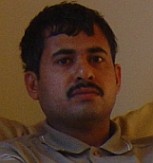

0 Comments:
Post a Comment
<< Home